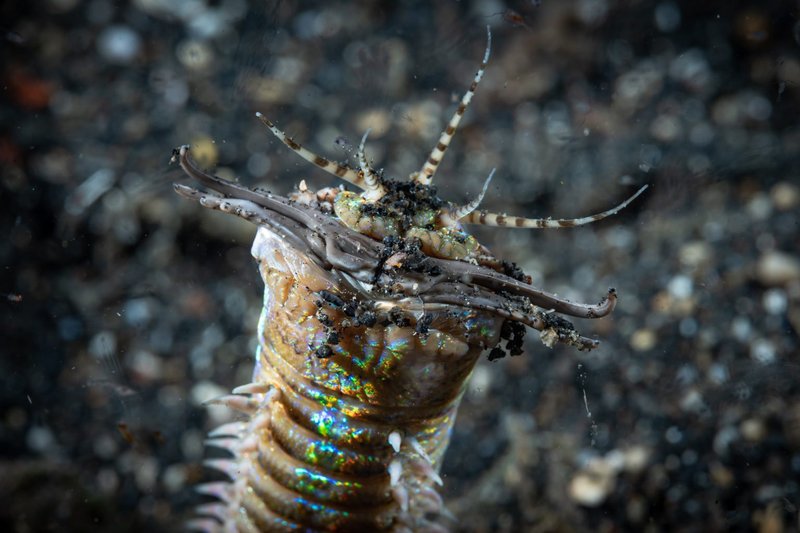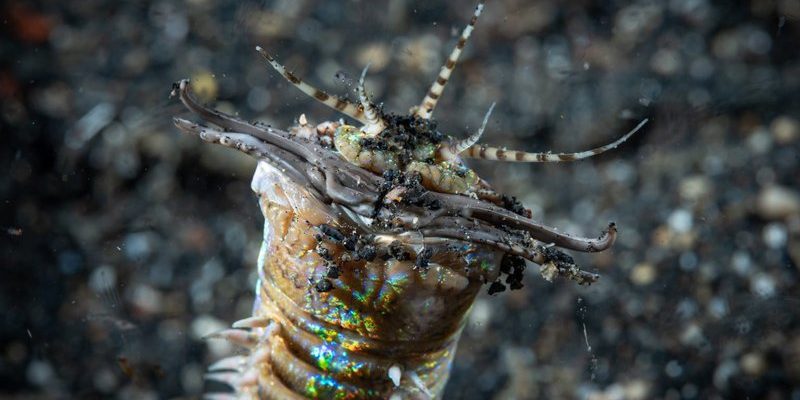
In simple terms, Bobbit worms are like the ninjas of the ocean. They’re stealthy, camouflaged, and armed with sharp jaws that can snap up unsuspecting prey. But just like every ninja, even the Bobbit worm has to watch its back. The marine ecosystem is a complex web of life, where every creature has its place. In this blog, we’ll uncover the predators of the Bobbit worm. Do they really have natural enemies, and if so, what are they? Let’s find out!
What Are Bobbit Worms?
Before we discuss their predators, it’s essential to understand what Bobbit worms are. These fascinating creatures belong to the *Eunice* genus and are found in warm, tropical waters around the world, often living in sandy or muddy substrates. They can grow to impressive lengths of up to 10 feet, although most are shorter. Their bodies are segmented, with vibrant colors ranging from green to red, making them look like something out of a science fiction movie.
Bobbit worms are predatory, using a method called *sit-and-wait* hunting. They extend their bodies, hiding in their burrows, while only their fierce jaws remain visible. When a fish or other unsuspecting prey swims too close, the Bobbit worm strikes with incredible speed, grabbing its meal and pulling it back into its burrow. This method of hunting is highly effective, making them formidable in their environment.
Interestingly, Bobbit worms can also regenerate lost segments of their bodies, which adds another layer to their resilience. This ability not only helps them survive encounters but could also make them even more intimidating to potential predators, creating a robust cycle of nature where survival is a constant battle.
Predators of the Bobbit Worm
You might be surprised to learn that Bobbit worms do have natural enemies! In the vast ocean, there are a few species known to prey on these fascinating creatures. The main predators include larger fish, certain types of sea turtles, and even other marine invertebrates. Let’s explore these predators a bit more.
Larger Fish
Many larger fish, particularly those that dwell near the ocean floor, consider Bobbit worms to be a delightful treat. Species like groupers and eels have the strength and speed necessary to dig out these elusive worms from their burrows. These fish are very skilled hunters; they can even smell the Bobbit worm in the water, making it easier for them to locate their prey.
Another factor that makes larger fish effective Bobbit worm predators is their ability to withstand the pain of the worm’s sharp jaws during ambush attempts. This is crucial because it allows them to snatch the worm before it retreats back into its burrow. Honestly, it’s like a game of cat and mouse, only this time, it’s under the sea.
Sea Turtles
While sea turtles are mostly known for eating jellyfish and seaweed, some species are also opportunistic feeders. This means they’ll munch on whatever they can find, including Bobbit worms. Their powerful jaws can crush the worm’s body, making it a quick and easy snack.
What’s interesting is that sea turtles have a hard shell, which protects them from the Bobbit worm’s defensive strikes. They can go after the worm without risking injury, making them one of the more significant threats to these marine creatures.
Other Marine Invertebrates
Believe it or not, some marine invertebrates can also pose a threat to the Bobbit worm. For instance, octopuses have been known to dig into the burrows of Bobbit worms. Their intelligence and dexterity allow them to outsmart these worms, making them effective predators.
These invertebrates possess the ability to quickly assess and adapt to their environment, often using their skills to extract the worm before it can react. Imagine being hunted by a creature as clever as an octopus! It really showcases the diverse and sometimes brutal nature of ocean life.
Why Do These Predators Matter?
Understanding Bobbit worm predators is crucial for a couple of reasons. Firstly, it highlights the interconnectedness of marine ecosystems. Every species plays a role, whether as prey or predator. This balance helps maintain the health of ocean environments, supporting countless other life forms.
Secondly, this knowledge can guide conservation efforts. If we recognize the natural threats to Bobbit worms and how they fit into the food chain, we can better protect them and their habitats. This is especially important as human activity continues to alter ocean ecosystems. Exploring the dynamics between species can strengthen our understanding of marine biology and ecosystem management.
What Happens if Bobbit Worms Face Decline?
If Bobbit worms were to face a decline in numbers, the ripple effect could be significant. Since they are predators themselves, their absence might lead to an overpopulation of smaller marine creatures. This overpopulation can disrupt the balance of the ecosystem, causing changes in vegetation and other marine species.
Moreover, their decline could impact larger fish and sea turtles, leading to food shortages for these predators. Essentially, the entire marine food web relies on the delicate balance maintained by each of its players. It’s like a card tower—remove one card, and the whole structure could collapse.
Bobbit worms, while fierce predators themselves, are not invincible. Their existence is woven into a complex tapestry of life under the sea, where predators and prey coexist in an ever-changing environment. From larger fish and sea turtles to clever octopuses, these creatures show that in nature, everyone has their role.
As we learn more about the Bobbit worm and its natural enemies, we appreciate the delicate balance of marine ecosystems. So, the next time you think about the ocean’s wonders, remember the hidden dramas playing out beneath the waves. The story of the Bobbit worm is just one chapter in a much bigger tale of survival, adaptation, and interconnectedness.

